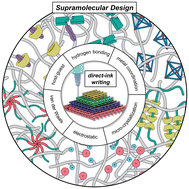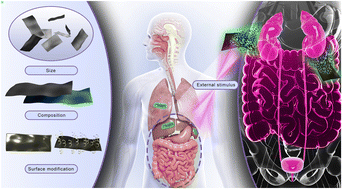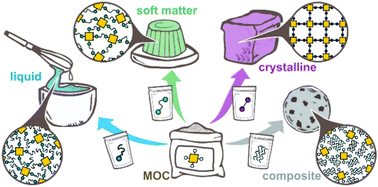Themed collection ChemSocRev – Highlights from 2023

π-Electronic ion pairs: building blocks for supramolecular nanoarchitectonics viaiπ–iπ interactions
Ion pairs comprising π-electronic cations and anions, formed viaiπ–iπ interactions with synergetically worked electrostatic and dispersion forces, and their properties for potential applications as functional materials are summarized.

Chem. Soc. Rev., 2023,52, 7170-7196
https://doi.org/10.1039/D3CS00581J
Ionic liquids revolutionizing biomedicine: recent advances and emerging opportunities
This review highlights the recent advances and emerging opportunities of ionic liquids in biomedicine based on their intrinsic advantages and potentials.

Chem. Soc. Rev., 2023,52, 7262-7293
https://doi.org/10.1039/D3CS00510K
Proton transfer kinetics of transition metal hydride complexes and implications for fuel-forming reactions
This review discusses proton transfer kinetics for reactions involving transition metal hydride complexes, highlighting the techniques used to measure proton transfer rate constants and the implications for fuel-forming reactions.

Chem. Soc. Rev., 2023,52, 7137-7169
https://doi.org/10.1039/D3CS00355H
Green metrics in mechanochemistry
The quantitative assessment of the greenness of mechanochemical processes for green metrics were calculated is herein reported. A general introduction to the topic, variables influencing the reaction outcome and, an outlook are also provided.

Chem. Soc. Rev., 2023,52, 6680-6714
https://doi.org/10.1039/D2CS00997H
Development of flow battery technologies using the principles of sustainable chemistry
A comprehensive analysis of flow battery technologies from the aspect of sustainable chemistry is provided and 9 principles have been proposed to evaluate a flow battery's technical and environmental sustainability.

Chem. Soc. Rev., 2023,52, 6031-6074
https://doi.org/10.1039/D2CS00765G
Click-derived multifunctional metal complexes for diverse applications
Numerous complex architectures are possible through Click reactions which display high specificity, flexibility and modularity. Click chemistry has addressed many challenges in the biomedical field, including drug delivery and theranostics.

Chem. Soc. Rev., 2023,52, 5051-5087
https://doi.org/10.1039/D3CS00343D
Asymmetric arene hydrogenation: towards sustainability and application
This review summarises the state-of-the-art in transition-metal catalysed asymmetric hydrogenation of (hetero)arenes and highlights recent advances with a special focus on sustainability while also addressing its shortcomings.

Chem. Soc. Rev., 2023,52, 4996-5012
https://doi.org/10.1039/D3CS00329A
Frustrated Lewis pair chemistry of CO
This review discusses the application of FLPs to the capture, reactivity, and reduction of CO. These developments illustrate an alternative strategy to advance the reactivity of CO.

Chem. Soc. Rev., 2023,52, 4632-4643
https://doi.org/10.1039/D3CS00294B
Recent progress in the development of fluorescent probes for imaging pathological oxidative stress
Oxidative stress is closely related to the physiopathology of numerous diseases. Reactive oxygen species (ROS), reactive nitrogen species (RNS), and reactive sulfur species (RSS) are direct participants and important biomarkers of oxidative stress.

Chem. Soc. Rev., 2023,52, 3873-3926
https://doi.org/10.1039/D2CS00172A
Raman spectroscopy, an ideal tool for studying the physical properties and applications of metal–organic frameworks (MOFs)
This review discusses Raman spectroscopic investigations of metal–organic framework (MOF) materials to understand the structural transitions, defects, guest adsorption, and catalytic reactions during various environmental and energy applications.

Chem. Soc. Rev., 2023,52, 3397-3437
https://doi.org/10.1039/D2CS01004F
Recent advances in the synthesis and applications of macrocyclic arenes
In this review, we summarize the recent advances in newly reported macrocyclic arenes, focusing on their synthetic strategies and applications.

Chem. Soc. Rev., 2023,52, 3265-3298
https://doi.org/10.1039/D3CS00002H
Emerging electrolytes with fluorinated solvents for rechargeable lithium-based batteries
This review provides a detailed analysis and summary of the design principles and strategies for the synthesis of fluorinated electrolyte solvents for Li-based batteries.

Chem. Soc. Rev., 2023,52, 2713-2763
https://doi.org/10.1039/D2CS00873D
Glycopolymers against pathogen infection
Glycomacromolecules show significant potential as antimicrobials. We highlight recent studies on their performance in hindering host cell entry and biofilm formation, and their potential as drug delivery and diagnostic agents.

Chem. Soc. Rev., 2023,52, 2617-2642
https://doi.org/10.1039/D2CS00912A
Enroute sustainability: metal free C–H bond functionalisation
The metal-free C–H functionalisation is providing environmentally benign, cost-effective, sustainable catalytic systems. Comprehensive developments of various metal-free C–H functionalisation reactions are the focal point of this review.

Chem. Soc. Rev., 2023,52, 2391-2479
https://doi.org/10.1039/D0CS01466D
The role of the light source in antimicrobial photodynamic therapy
Antimicrobial photodynamic therapy (APDT) is a promising approach to fight the growing problem of antimicrobial resistance that threatens health care, food security and agriculture. Suitable light sources include lasers, LEDs, OLEDs and lamps.

Chem. Soc. Rev., 2023,52, 1697-1722
https://doi.org/10.1039/D0CS01051K
Advanced supramolecular design for direct ink writing of soft materials
This review draws connections between top-down direct-ink-writing and bottom-up supramolecular designs. Examples of supramolecularly designed viscoelastic inks and perspectives of using supramolecular motifs for 3D printing have been discussed.

Chem. Soc. Rev., 2023,52, 1614-1649
https://doi.org/10.1039/D2CS01011A
Ultrafast materials synthesis and manufacturing techniques for emerging energy and environmental applications
This review provides an overview of emerging ultrafast synthesis technologies for energy and environmental applications. Representative ultrafast methods include Joule heating, plasma, laser, infrared, microwave, and flame-assisted synthesis, etc.

Chem. Soc. Rev., 2023,52, 1103-1128
https://doi.org/10.1039/D2CS00322H
Chemically engineering cells for precision medicine
This review summarizes chemical tools for cell engineering, introduces their wide application in diagnosis and therapy, and discusses the challenges and opportunities in precision medicine.

Chem. Soc. Rev., 2023,52, 1068-1102
https://doi.org/10.1039/D2CS00142J
Noncancerous disease-targeting AIEgens
Schematic diagram of noncancerous disease-targeting AIEgens.

Chem. Soc. Rev., 2023,52, 1024-1067
https://doi.org/10.1039/D2CS00610C
Polymersome-based protein drug delivery – quo vadis?
Block copolymer vesicles are well suited as nano-sized drug delivery vehicles for therapeutic proteins. However, they have not reached the clinic yet. Why? The review discusses opportunities and obstacles of polymersome-based protein drug delivery.

Chem. Soc. Rev., 2023,52, 728-778
https://doi.org/10.1039/D2CS00106C
Uranium extraction from seawater: material design, emerging technologies and marine engineering
Uranium extraction from seawater (UES), a potential approach to securing the long-term uranium supply and sustainability of nuclear energy, has experienced significant progress in the past decade.

Chem. Soc. Rev., 2023,52, 97-162
https://doi.org/10.1039/D2CS00595F
Noncovalently bound and mechanically interlocked systems using pillar[n]arenes
This review discusses pillar[n]arene-based MIMs such as rotaxanes, catenanes, polyrotaxanes, single-component mechanically self-locked molecules, and supramolecular polymers.
![Graphical abstract: Noncovalently bound and mechanically interlocked systems using pillar[n]arenes](/en/Image/Get?imageInfo.ImageType=GA&imageInfo.ImageIdentifier.ManuscriptID=D2CS00169A&imageInfo.ImageIdentifier.Year=2022)
Chem. Soc. Rev., 2022,51, 3648-3687
https://doi.org/10.1039/D2CS00169A
Skin bioelectronics towards long-term, continuous health monitoring
Skin bioelectronics for long-term, continuous health monitoring opens unprecedented opportunities for timely disease management. This review summarized representative healthcare sensing, desired materials and designs, and various bio-signal analysis.

Chem. Soc. Rev., 2022,51, 3759-3793
https://doi.org/10.1039/D2CS00207H
Surface functionalization of inorganic nanoparticles with ligands: a necessary step for their utility
The importance of protecting inorganic nanoparticles with organic ligands and thus imparting the needed stabilization as colloidal dispersions for their potential applications is highlighted in this review.

Chem. Soc. Rev., 2023,52, 2573-2595
https://doi.org/10.1039/D1CS00876E
Progress and perspective for conversion of plastic wastes into valuable chemicals
We divide the up-to-date techniques into two categories: technologies executed under violent conditions and mild conditions, and we present a timely summary of the mechanism of bond cleavage in plastic waste to produce valuable chemicals.

Chem. Soc. Rev., 2023,52, 8-29
https://doi.org/10.1039/D2CS00688J
Biodistribution, degradability and clearance of 2D materials for their biomedical applications
This review focuses on recent advances in the biodistribution, biodegradation, and metabolic studies of 2D materials for their biomedical applications.

Chem. Soc. Rev., 2022,51, 7732-7751
https://doi.org/10.1039/D1CS01070K
Assembling metal–organic cages as porous materials
Metal–organic cages are processable porous molecules that can be assembled into a range of macroscopic porous materials.

Chem. Soc. Rev., 2022,51, 4876-4889
https://doi.org/10.1039/D1CS00759A
Recent advances in low-power-threshold nonlinear photochromic materials
This tutorial review introduces basics and recent advances of low-power-threshold nonlinear photochromic materials. We attempt to provide an intuitive understanding of incoherent nonlinear optical processes using fundamental concepts.

Chem. Soc. Rev., 2022,51, 2397-2415
https://doi.org/10.1039/D1CS01144H
About this collection
In this collection, we showcase some of the most cited and most downloaded articles published in ChemSocRev throughout 2023. This selection of review articles covers a wide-range of important topics at the forefront of the chemical sciences.